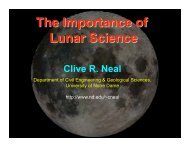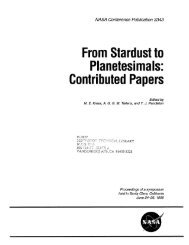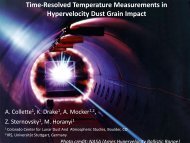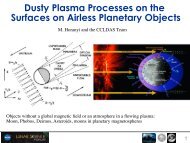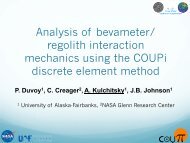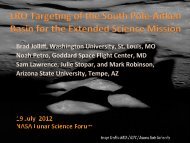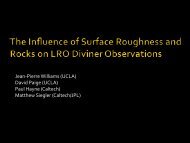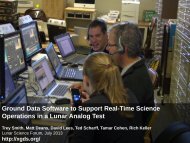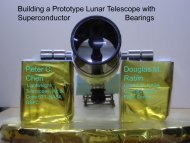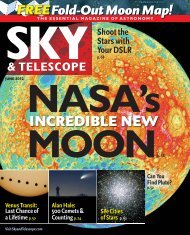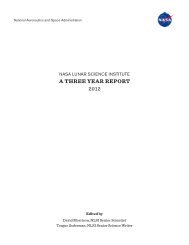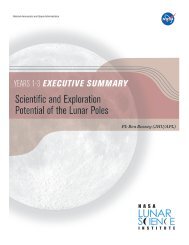Neutron Suppression Regions at the Lunar Poles Part 1 - NASA Lunar ...
Neutron Suppression Regions at the Lunar Poles Part 1 - NASA Lunar ...
Neutron Suppression Regions at the Lunar Poles Part 1 - NASA Lunar ...
Create successful ePaper yourself
Turn your PDF publications into a flip-book with our unique Google optimized e-Paper software.
<strong>Neutron</strong> <strong>Suppression</strong> <strong>Regions</strong> <strong>at</strong><br />
<strong>the</strong> <strong>Lunar</strong> <strong>Poles</strong><br />
<strong>Part</strong> 1:<br />
LEND d<strong>at</strong>a quality<br />
William Boynton<br />
<strong>Lunar</strong> Science Forum<br />
July 18, 2012
Why this part of present<strong>at</strong>ion?<br />
• <strong>Lunar</strong> vol<strong>at</strong>iles session <strong>at</strong> 2012 LPSC<br />
• Two talks had nothing to do with lunar vol<strong>at</strong>iles<br />
• They were <strong>the</strong>re to criticize <strong>the</strong> LEND d<strong>at</strong>a quality<br />
• No time for rebuttal<br />
• Comment to a blog on behind<strong>the</strong>black.com<br />
• “You neglect to mention yet ano<strong>the</strong>r possibility — th<strong>at</strong> this paper<br />
and its conclusions are seriously flawed in almost every respect.”<br />
Paul Spudis<br />
• We should be beyond this by now.
Excellent sp<strong>at</strong>ial resolution<br />
• Epi<strong>the</strong>rmal neutron flux<br />
along 45° - 225° longitude<br />
shows a large decrease <strong>at</strong><br />
Shoemaker Cr<strong>at</strong>er.<br />
• Rel<strong>at</strong>ive to low-H region in<br />
low l<strong>at</strong>itudes, decrease is<br />
<strong>at</strong> 12 sigma.<br />
• Rel<strong>at</strong>ive to terrain 200 km<br />
away, it is still <strong>at</strong> 8 sigma.<br />
• Can’t be by chance<br />
page3
LEND resolution vs LPNS<br />
• Critics have said LEND<br />
resolution should not be<br />
significantly better than<br />
th<strong>at</strong> of LPNS.<br />
• You be <strong>the</strong> judge.<br />
page4
LEND d<strong>at</strong>a averaged in rings<br />
• Smoothing improves<br />
st<strong>at</strong>istics, but it degrades<br />
sp<strong>at</strong>ial resolution.<br />
• Unsmoo<strong>the</strong>d d<strong>at</strong>a are<br />
averaged in four different<br />
sized annuli around<br />
Shoemaker.<br />
• D<strong>at</strong>a show large<br />
uncertainties but also a<br />
large suppression.<br />
page5
Sp<strong>at</strong>ial resolution is as st<strong>at</strong>ed<br />
• The d<strong>at</strong>a were fit to a<br />
Gaussian<br />
• Width of <strong>the</strong> Gaussian =<br />
6.4 ± 1.7 km<br />
• Equivalent to half width <strong>at</strong><br />
half counts = 4.3 ± 1.2 km.<br />
• Width cited in Mitrofanov<br />
et al., 2008 was 5 km.<br />
page6
Reduced chi squared test<br />
• Reduced chi squared<br />
test is a good test to<br />
see if <strong>the</strong> sc<strong>at</strong>ter in<br />
<strong>the</strong> d<strong>at</strong>a is consistent<br />
with estim<strong>at</strong>ed<br />
uncertainties.<br />
• If uncertainties are<br />
properly estim<strong>at</strong>ed,<br />
chi squared will be<br />
about 1.0<br />
• Graph is 14 degrees<br />
of freedom, i.e.<br />
averaging 15 points.<br />
page7
LEND uncertainties are proper<br />
• In making our maps,<br />
we need to average 15<br />
values 3263 times.<br />
• Histogram of 3263<br />
different determin<strong>at</strong>ions<br />
of reduced chi squared<br />
show th<strong>at</strong> our<br />
uncertainties account<br />
for all <strong>the</strong> sc<strong>at</strong>ter in <strong>the</strong><br />
d<strong>at</strong>a.<br />
page8
Early and l<strong>at</strong>e maps compared<br />
• First half and second half of d<strong>at</strong>a look very different when not<br />
processed properly. Dynamic range is 3.8 to 6.2 cps.<br />
• Our biggest suppression is 0.2 cps, so <strong>at</strong> this scale we see only noise.<br />
page9
Smoo<strong>the</strong>d d<strong>at</strong>a<br />
• <strong>Suppression</strong>s are 0.1 to 0.2 cps; uncertainties are 0.01 to 0.02 cps<br />
Count R<strong>at</strong>e Uncertainty<br />
page10
Summary<br />
• LEND maps with proper smoothing show st<strong>at</strong>istically<br />
valid suppressions.<br />
• LEND sp<strong>at</strong>ial resolution is just as advertised<br />
• LEND uncertainties are properly estim<strong>at</strong>ed.<br />
• They account for all sc<strong>at</strong>ter in <strong>the</strong> d<strong>at</strong>a.<br />
page11
<strong>Neutron</strong> <strong>Suppression</strong> <strong>Regions</strong> <strong>at</strong><br />
<strong>the</strong> <strong>Lunar</strong> <strong>Poles</strong><br />
<strong>Part</strong> 2: Science results<br />
Igor Mitrofanov, Maxim Litvak<br />
<strong>Lunar</strong> Science Forum<br />
July 18, 2012
Global maps of epi<strong>the</strong>rmal neutron flux show <strong>the</strong> existence of extended<br />
suppression (~5%) of epi<strong>the</strong>rmal neutron flux <strong>at</strong> <strong>the</strong> polar regions of<br />
Moon poleward 70N/70S.
<strong>Neutron</strong> flux from North polar region with resolution ~50km<br />
LEND (Litvak et al.,2012) LPNS (Feldman et al., 2001)<br />
H-rich areas
<strong>Neutron</strong> flux from South polar region with resolution ~50 km<br />
LEND (Litvak et al., 2012) LPNS (Feldman et al., 2001)<br />
H-rich areas
Hydrogen <strong>at</strong> Moon <strong>Poles</strong>:<br />
There are two possible sources of hydrogen found on <strong>the</strong> moon:<br />
H 2 O from impacts of vol<strong>at</strong>ile-rich comets or meteorites.<br />
H cre<strong>at</strong>ed in <strong>the</strong> subsurface due to interaction with protons of <strong>the</strong> solar wind<br />
or solar particle events (SPEs). H-vol<strong>at</strong>iles can be accumul<strong>at</strong>ed in <strong>the</strong> cold<br />
traps in <strong>the</strong> quantities comparable with <strong>the</strong> predictions derived from neutron<br />
spectroscopy d<strong>at</strong>a.
§ W<strong>at</strong>er on <strong>the</strong> Moon has also been recently detected by IR imaging spectrometers (Clark et<br />
al., 2006; Sunshine et al., 2006; Pieters et al., 2006); <strong>the</strong> IR d<strong>at</strong>a have shown th<strong>at</strong> <strong>the</strong><br />
content of w<strong>at</strong>er (or OH group) is gradually increasing toward both poles.<br />
§ Recently, <strong>the</strong> joint efforts of <strong>NASA</strong>`s LRO and LCROSS missions have provided <strong>the</strong> most<br />
direct evidence to d<strong>at</strong>e th<strong>at</strong> regolith of <strong>the</strong> sou<strong>the</strong>rn polar cr<strong>at</strong>er Cabeus contains<br />
significant amounts of w<strong>at</strong>er and o<strong>the</strong>r vol<strong>at</strong>iles (Colaprete et al., 2010; Gladstone et al.,<br />
2010).<br />
§ The direct estim<strong>at</strong>ion of mass fraction of w<strong>at</strong>er in <strong>the</strong> Cabeus regolith gave about 5.6±2.9<br />
weight % by instruments onboard LCROSS (Colaprete et al., 2010).<br />
§ Therefore, one may conclude th<strong>at</strong> enhanced content of hydrogen and/or w<strong>at</strong>er <strong>at</strong> <strong>the</strong> lunar<br />
poles is experimentally proven and et least one local spot enriched with w<strong>at</strong>er is detected<br />
in <strong>the</strong> cr<strong>at</strong>er Cabeus.<br />
§ Several questions arise: Where are ano<strong>the</strong>r spots of w<strong>at</strong>er-rich permafrost <strong>at</strong> <strong>the</strong> lunar<br />
poles? Are <strong>the</strong>y coincide with PSRs? How much do w<strong>at</strong>er-rich spots contribute to <strong>the</strong> bulk<br />
quantity of polar w<strong>at</strong>er on <strong>the</strong> Moon?<br />
The d<strong>at</strong>a from neutron telescope LEND (selected for <strong>NASA</strong>`s LRO mission) could be<br />
analyzed to provide answers to <strong>the</strong>se questions. LEND collim<strong>at</strong>ed neutrons detectors are able<br />
to measure epi<strong>the</strong>rmal neutron emission with high sp<strong>at</strong>ial resolution of about 5 km (HWHM) <strong>at</strong><br />
altitude of 50 km. It is comparable with possible local spots of H enhancement.
Polar maps of epi<strong>the</strong>rmal neutron flux with different sp<strong>at</strong>ial<br />
resolution<br />
Omni-directions sensor<br />
FWHM~75 km<br />
Collim<strong>at</strong>ed sensors<br />
FWHM~10 km
TASK I: To test <strong>the</strong> hypo<strong>the</strong>sis th<strong>at</strong> w<strong>at</strong>er ice deposits exist in cold traps of<br />
Permanently Shadowed <strong>Regions</strong> (PSRs)<br />
Model with strong<br />
suppression in PSRs<br />
pole pole<br />
BACKGROUND, as a<br />
cold regolith with<br />
enhanced content of H<br />
about 100 ppm SIGNALS, as PSRs<br />
with w<strong>at</strong>er ice
Total neutron counts r<strong>at</strong>e<br />
L<strong>at</strong>itude<br />
60° - 70°<br />
reference<br />
l<strong>at</strong>itude belt<br />
Extended polar<br />
suppression of<br />
epi<strong>the</strong>rmal<br />
neutrons<br />
SIGNAL from a testing PSR<br />
PSR<br />
BACKGROUND is <strong>the</strong> Extended<br />
<strong>Neutron</strong> <strong>Suppression</strong> Region<br />
LEND<br />
PSR contour from LOLA<br />
to equ<strong>at</strong>or pole<br />
to equ<strong>at</strong>or
RESULTS of testing SIGNAL (local suppressions) <strong>at</strong> PSRs: list of largest cases
We selected only <strong>the</strong> large PSRs with areas gre<strong>at</strong>er than 100 km 2 (comparable with<br />
<strong>the</strong> LEND footprint) There are 47 such PSRs in <strong>the</strong> South (30) and North (17) polar<br />
regions. Their area ranges from ~100 km 2 up to > 1000 km 2 .<br />
North South<br />
Local suppression parameter measured for each large nor<strong>the</strong>rn and sou<strong>the</strong>rn PSRs.<br />
It is presented as a function of exposure time accumul<strong>at</strong>ed during LEND<br />
observ<strong>at</strong>ions for each PSR. The dashed lines correspond to <strong>the</strong> 3σ upper limits for<br />
excess (positive values) and suppression (neg<strong>at</strong>ive values), respectively.
Distribution of<br />
simul<strong>at</strong>ed counting r<strong>at</strong>e inside PSR<br />
based on <strong>the</strong> 2% local suppression<br />
Real distribution of<br />
large PSRs<br />
Distribution of<br />
simul<strong>at</strong>ed counting r<strong>at</strong>e inside PSR<br />
based on <strong>the</strong> zero local suppression<br />
Distribution of counting r<strong>at</strong>es measured inside large PSRs (surface area > 200 km 2 ) shown by<br />
solid black line. The distribution of simul<strong>at</strong>ed counting r<strong>at</strong>es for <strong>the</strong>se PSRs based on<br />
assumption of zero local suppression is shown by <strong>the</strong> dashed line. The distribution of<br />
simul<strong>at</strong>ed counting r<strong>at</strong>es for <strong>the</strong>se PSRs based on assumption of best fit local suppression is<br />
shown by <strong>the</strong> dotted line.
CONCLUSIONS for <strong>the</strong> TASK I<br />
1. Some large PSRs have enhancement of Hydrogen: >250 ppm in Shoemaker, >500 ppm<br />
in Cabeus. Shoemaker and Cabeus are <strong>the</strong> best candid<strong>at</strong>es for PSRs with w<strong>at</strong>er ice.<br />
For example, LEND estim<strong>at</strong>ions of w<strong>at</strong>er distribution in Cabeus (using double-layered<br />
model with poor H-m<strong>at</strong>erial on <strong>the</strong> top) may be as high as 4% wt.<br />
2. There is no st<strong>at</strong>istically significant difference of neutron suppressions for most of<br />
largest PSRs in comparison with <strong>the</strong>ir local sunlit vicinity. But <strong>the</strong>y tend to<br />
demonstr<strong>at</strong>e less (by ~2% in average) neutron emission than surrounding areas.<br />
Based on <strong>the</strong>se results, one may consider ano<strong>the</strong>r TASK II:<br />
To search for local NEUTRON SUPPRESSION REGIONS (NSRs) based only on <strong>the</strong><br />
LEND neutron mapping d<strong>at</strong>a without any a priory inform<strong>at</strong>ion.
Total neutron counts r<strong>at</strong>e<br />
L<strong>at</strong>itude<br />
60° - 70°<br />
reference<br />
l<strong>at</strong>itude belt<br />
Extended polar<br />
suppression of<br />
epi<strong>the</strong>rmal<br />
neutrons<br />
SIGNAL from <strong>Neutron</strong><br />
<strong>Suppression</strong> Region<br />
NER<br />
SIGNAL from a <strong>Neutron</strong><br />
Excess Region<br />
NSR<br />
BACKGROUND is <strong>the</strong> Extended<br />
<strong>Neutron</strong> <strong>Suppression</strong> Region<br />
LEND<br />
to equ<strong>at</strong>or pole<br />
to equ<strong>at</strong>or
NSRs were found, as st<strong>at</strong>istically significant decreases of epi<strong>the</strong>rmal neutron<br />
emission by 2.5% and 5.0% from <strong>the</strong> level of Extended <strong>Suppression</strong>
Example of contour of<br />
NSR in <strong>the</strong> vicinity of<br />
Cabeus area.<br />
Blue line – first half of LRO<br />
mapping<br />
Red line – Full LRO<br />
mapping
<strong>Neutron</strong> flux inside <strong>Neutron</strong> suppress/excess regions: possible<br />
correl<strong>at</strong>ion with surface properties (temper<strong>at</strong>ure and illumin<strong>at</strong>ion)
<strong>Neutron</strong> <strong>Suppression</strong>/Excess <strong>Regions</strong> vs local temper<strong>at</strong>ure effect<br />
Cabeus Shoemaker<br />
Local effect of suppression/excess of neutron flux inside NSR/NER measured in % (vertical axis) vs<br />
absolute difference (horizontal axis) between a temper<strong>at</strong>ure inside NSR/NER and average<br />
temper<strong>at</strong>ure <strong>at</strong> given l<strong>at</strong>itude (including given NSR/NER). The red points represent six spots, which<br />
have <strong>the</strong> property “less local irradi<strong>at</strong>ion and lower temper<strong>at</strong>ure – fewer local neutrons”.<br />
<strong>Neutron</strong> Excess <strong>Regions</strong><br />
<strong>Neutron</strong> Suppress <strong>Regions</strong>
CONCLUSIONS for <strong>the</strong> TASK II<br />
q Analysis of <strong>the</strong> LEND maps of epi<strong>the</strong>rmal neutron emission <strong>at</strong> <strong>the</strong> lunar poles shows<br />
th<strong>at</strong> <strong>the</strong>re is effect of significant vari<strong>at</strong>ions of neutron emission <strong>at</strong> local spots called as<br />
<strong>Neutron</strong> <strong>Suppression</strong> <strong>Regions</strong> (NSRs) and <strong>Neutron</strong> Excess <strong>Regions</strong> (NERs).<br />
q Some of NSRs are loc<strong>at</strong>ed in <strong>the</strong> vicinity of PSRs but do not coincide with <strong>the</strong>m.<br />
q All selected spots have been studied using independent d<strong>at</strong>a for solar irradi<strong>at</strong>ion from<br />
LOLA and for average surface temper<strong>at</strong>ure from Diviner. It was found th<strong>at</strong> some<br />
neutron suppress regions have significantly different temper<strong>at</strong>ure and illumin<strong>at</strong>ion in<br />
comparison with <strong>the</strong> average estim<strong>at</strong>es <strong>at</strong> <strong>the</strong>ir l<strong>at</strong>itudes.<br />
q These suppress regions follow empirical law “less local irradi<strong>at</strong>ion and lower<br />
temper<strong>at</strong>ure – fewer local neutrons”. We assume th<strong>at</strong> <strong>the</strong> hydrogen content is <strong>the</strong><br />
driving factor for this law.



